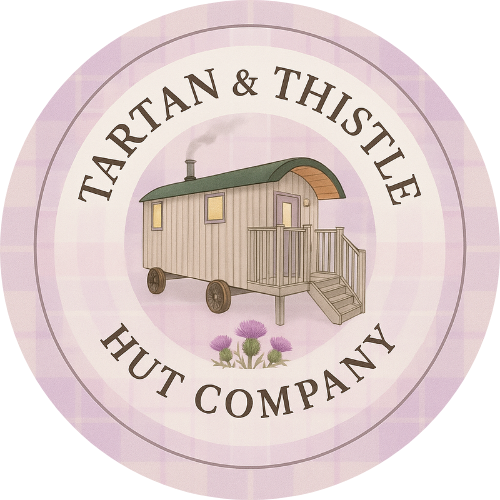Should I Rent My Hut All Year Round?
Exploring the Seasons of Letting — from Summer Stays to Winter Retreats.
By Tartan & Thistle Hut Co.
A crackling woodburner adds that year-round comfort to your shepherd’s hut — perfect for cosy autumn nights and snowy winter escapes in the Highlands.
If you own one of our handcrafted huts, a common question arises: should you offer it as a holiday let all year round, or stick to the warmer months when bookings feel guaranteed? While Highland summers bring long, bright days and high demand, winter has its own quiet charm — and surprising earning potential.
Here’s a look at the benefits and drawbacks of year-round letting, and how to make the most of the colder season.
A breathtaking view of the Northern Lights dancing across the Highland sky, seen from the cosy interior of a Sutherland based, handcrafted Tartan & Thistle Cabin.
Summer vs Winter: What the Numbers Say
While summer in the Highlands often brings near-full calendars, the quieter months can still generate meaningful income. According to short-term rental data from sources like Sykes Cottages and AirDNA, Highland holiday lets bring in an average of £2,700–£2,900 per month. During winter, this may drop to around £1,700 per month, while peak summer months can reach or exceed £3,700.
That means even in the depth of winter, many huts still offer a steady stream of income — especially when marketed well.
The Upsides of Winter Letting
Festive Premiums
Christmas, Hogmanay, and Valentine’s Day are peak opportunities to charge higher rates. Guests are often drawn to the romance of a remote cabin decked with fairy lights, a roaring fire, and the possibility of snow on the hills.
Romantic Getaways
The Highlands in winter offer something deeply atmospheric: frost-kissed landscapes, dramatic skies, the stillness of the lochs, and dark nights perfect for stargazing. With the right touches, your hut can become a perfect escape for couples seeking peace and privacy.
Boost to Annual Income
Letting your hut year-round could add £10,000–£12,000 to your yearly income, depending on demand and how well you market the property. While you may not be full every week in winter, the bookings that do come through can still offer solid returns — especially over holidays.
Shepherd’s hut, built by our team, with an outdoor hot tub in the Scottish Highlands. Ideal for romantic getaways and year-round relaxation.
Considerations and Challenges
Lower Base Rates
Outside of the key holidays, weekly rates may need to be more competitive. Guests often expect a lower price in exchange for colder weather and shorter days.
Running Costs
Heating, insulation, firewood, and upkeep all cost more in winter. You’ll need to factor in these seasonal expenses — especially if your hut is in a remote or exposed location.
Shepherd’s hut site surrounded by 3ft of snow in the Scottish Highlands, illustrating the beauty and potential challenges of winter holiday letting.
Weather and Accessibility
Heavy snow or icy conditions may impact access. You might face cancellations or need contingency plans in place for guests. Paths and driveways may need to be gritted or cleared.
Tips to Maximise Winter Earnings
If you decide to rent through the colder months, lean into the season and what makes your location special:
Create festive and romantic packages — include welcome hampers with local treats, fizz, or cosy extras.
Add a wood-fired outdoor sauna — these are incredibly popular in the off-season. The contrast of steam and crisp air is a major draw, especially when paired with the amazing scenic views we are lucky to have here in the Highlands!
Install a hot tub or plunge tub — properties with these features often earn 20–30% more per booking in winter.
Emphasise warmth and atmosphere — thick throws, soft lighting, natural textures, and log burners all contribute to that sought-after ‘hygge’ feel.
Use flexible pricing — offer short mid-week breaks, last-minute deals, or discounted stays to fill quieter gaps.
Collaborate locally — partner with nearby cafes, farm shops, or adventure providers to offer discounts or experiences that enhance your guests’ stays.
Income Comparison: Seasonal vs Year-Round
Bar chart showing seasonal vs year-round letting income for shepherd’s huts in the Scottish Highlands, highlighting higher annual revenue from full-year availability.
In comparison, letting only April to September would bring in approximately £21,000 — so keeping your hut available year-round could add over £10,000 to your annual revenue.
So, Should You Rent All Year?
The answer depends on your goals.
If you’re looking to maximise income and are happy to manage winter-specific tasks like maintenance, guest communication, and weatherproofing, then year-round letting can offer real rewards.
If simplicity, ease of access, or minimal guest turnover are more important to you, then seasonal letting might suit better — with spring to early autumn still providing strong earnings.
A Final Note from the Highlands
Winter in the Highlands brings something quieter and more profound — a chance for guests to truly disconnect. With frozen landscapes, candlelight, and the hum of a stove, your hut can become a sanctuary. When paired with thoughtful extras like a sauna, soft textiles, and a view to the hills, winter lets can become some of the most memorable.
Whether you choose to let all year or just for the sunny months, your hut holds value far beyond its walls. It’s a slice of the Highlands — and someone out there is dreaming of it now.
What gives a warmer winter welcome than twinkling fairy lights, fresh Highland snow, and a cosy shepherd’s hut waiting just for you?






